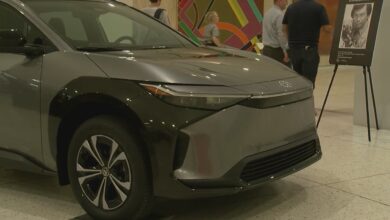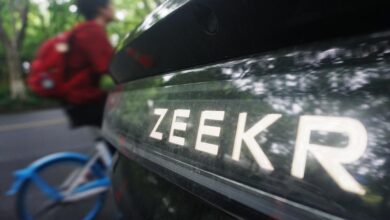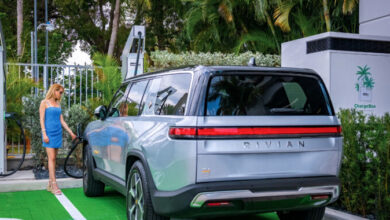Elon Musk Is Self-Driving Tesla Into the Ground

In a 1999 Forbes article, a pair of conservative lawyers, Peter Huber and Mark Mills, warned that personal computers and the internet were about to overwhelm the fragile U.S. grid.
Information technology already devoured 8% to 13% of total U.S. power demand, Huber and Mills claimed, and that share would only rise over time. “It’s now reasonable to project,” they wrote, “that half of the electric grid will be powering the digital-Internet economy within the next decade.” (Emphasis mine.)
Over the next 18 months, investment banks including JP Morgan and Credit Suisse repeated the Forbes estimate of internet-driven power demand, advising their customers to pile into utilities and other electricity-adjacent stocks. Although it was unrelated, California’s simultaneous blackout crisis deepened the sense of panic. For a moment, experts were convinced: Data centers and computers would drain the country’s energy resources.
They could not have been more wrong. In fact, Huber and Mills had drastically mismeasured the amount of electricity used by PCs and the internet. Computing ate up perhaps 3% of total U.S. electricity in 1999, not the roughly 10% they had claimed. And instead of staring down a period of explosive growth, the U.S. electric grid was in reality facing a long stagnation. Over the next two decades, America’s electricity demand did not grow rapidly — or even, really, at all. Instead, it flatlined for the first time since World War II. The 2000s and 2010s were the first decades without “load growth,” the utility industry’s jargon for rising power demand, since perhaps the discovery of electricity itself.
Now that lull is ending — and a new wave of tech-driven concerns has overtaken the electricity industry. According to its supporters and critics alike, generative artificial intelligence like ChatGPT is about to devour huge amounts of electricity, enough to threaten the grid itself. “We still don’t appreciate the energy needs of this technology,” Sam Altman, the CEO of OpenAI, has said, arguing that the world needs a clean energy breakthrough to meet AI’s voracious energy needs. (He is investing in nuclear fusion and fission companies to meet this demand.) TheWashington Post captured the zeitgeist with a recent story: America, it said, “is running out of power.”
But … is it actually? There is no question that America’s electricity demand is rising once again and that load growth, long in abeyance, has finally returned to the grid: The boom in new factories and the ongoing adoption of electric vehicles will see to that. And you shouldn’t bet against the continued growth of data centers, which have increased in size and number since the 1990s. But there is surprisingly little evidence that AI, specifically, is driving surging electricity demand. And there are big risks — for utility customers and for the planet — by treating AI-driven electricity demand as an emergency.
There is, to be clear, no shortage of predictions that AI will cause electricity demand to rise. According to a recent Reuters report, nine of the country’s 10 largest utilities are now citing the “surge” in power demand from data centers when arguing to regulators that they should build more power. Morgan Stanley projects that power use from data centers “is expected to triple globally this year,” according to the same report. The International Energy Agency more modestly — but still shockingly — suggests that electricity use from data centers, AI, and cryptocurrency could double by 2026.
These concerns have come not only from the business community, but also from environmentalists. A recent report from the Climate Action Against Disinformation Commission, a left-wing alliance of groups including Friends of the Earth and Greenpeace, warned that AI will require “massive amounts of energy and water” and called for aggressive regulation.
That report focused on the risks of an AI-addled social media public sphere, which progressives fear will be filled with climate-change-denying propaganda by AI-powered bots. But in an interview, Michael Khoo, an author of the report and a researcher at Friends of the Earth, told me that studying AI made him much more frightened about its energy use.
AI is such an power-suck that it “is causing America to run out of energy,” Khoo said. “I think that’s going to be much more disruptive than the disinformation conversation in the mid-term.” He sketched a scenario where Altman and Mark Zuckerberg can outbid ordinary households for electrons as AI proliferates across the economy. “I can see people going without power,” he said, “and there being massive social unrest.”
These predictions aren’t happening in a vacuum. At the same time that investment bankers and environmentalists have fretted over a potential electricity shortage, utilities across the South have proposed a de facto solution: a massive buildout of new natural-gas power plants.
Citing the return of load growth, utilities across the South are trying to go around normal regulatory channels and build a slew of new natural-gas-burning power plants. Across at least six states, utilities have already won — or are trying to win — permission from local governments to fast-track more than 10,000 megawatts of new gas-fired power plants so that they can meet the surge in demand.
These requests have popped up across the region, pushed by vertically integrated monopoly power companies. Georgia Power won a tentative agreement to build 1,400 new megawatts of gas capacity, Canary reported. In the Carolinas, Duke Energy has asked to build 9,000 megawatts of new gas capacity, triple what it previously requested. The Tennessee Valley Authority has plans to add 6,600 megawatts of new capacity to its grid.
This buildout is big enough to endanger the country’s climate targets. Although these utilities are also building new renewable and battery farms, and shutting down coal plants, the planned surge in carbon emissions from natural gas plants would erase the reductions from those changes, according to a Southern Environmental Law Center analysis. Duke Energy has already said that it will not meet its 2030 climate goal in order to conduct the gas expansion.
In the popular press, AI’s voracious energy demand is sometimes said to be a major driver of this planned gas boom. But evidence for that proposition is slim, and the utilities have said only that data center expansion is one of several reasons for the boom. The Southeast’s population is growing, and the region is experiencing a manufacturing renaissance, due in part to the new car, battery, and solar panel factories subsidized by Biden’s climate law. Utilities in the South also face a particular challenge coping with the coldest winter mornings because so many homes and offices use inefficient and power-hungry space heaters.
Indeed, it’s hard to talk about the drivers of load growth with any specificity — and it’s hard to know whether load growth will actually happen in all corners of the South.
Utilities compete against each other to secure big-name customers — much like local governments compete with sweetheart tax deals — so when a utility asks regulators to build more capacity, it doesn’t reveal where potentialpower demand is coming from. (In other words, it doesn’t reveal who it believes will eventually buy that power.) A company might float plans to build the same data center or factory in multiple states to shop around for the best rates, which means the same underlying gigawatts of demand may be appearing in several different utilities’ resource plans at the same time. In other words, utilities are unlikely to actually see all of the demand they’re now projecting.
Even if we did know exactly how many gigawatts of new demand each utility would see, it’s almost impossible to say how much of it is coming from AI. Utilities don’t say how much of their future projected power demand will come from planned factories versus data centers. Nor do they say what each data center does and whether it trains AI (or mines Bitcoin, which remains a far bigger energy suck).
The risk of focusing on AI, specifically, as a driver of load growth is that because it’s a hot new technology — one with national security implications, no less — it can rhetorically justify expensive emergency action that is actually not necessary at all. Utilities may very well need to build more power capacity in the years to come. But does that need constitute an emergency? Does it justify seeking special permission from their statehouses or regulators to build more gas, instead of going through the regular planning process? Is it worth accelerating approvals for new gas plants? Probably not. The real danger, in other words, is not that we’ll run out of power. It’s that we’ll build too much of the wrong kind.
At the same time, we might have been led astray by overly dire predictions of AI’s energy use. Jonathan Koomey, a researcher who studies how the internet and data centers use energy (and the namesake of Koomey’s Law) told me that many estimates of Nvidia’s most important AI chips assume that their energy use is the same as their advertised “rated” power. In reality, Nvidia chips probably use half of that amount, he said, because chipmakers engineer their chips to withstand more electricity than is necessary for safety reasons.
And this is just the current generation of chips: Nvidia’s next generation of AI-training chips, called “Blackwell,” use 25 times less energy to do the same amount of computation as the previous generation of chips.
Koomey helped defuse the last panic over energy use by showing that the estimates Huber and Mills relied on were wildly incorrect. Estimates now suggest that the internet used less than 1% of total U.S. electricity by the late 1990s, not 13% as they claimed. Those percentages stayedroughly the same through 2008, he later found, even as data centers grew and computers proliferated across the economy. That’s the same year, remember, that Huber and Mills predicted that the internet would consume half of American energy.
These bad predictions were extremely convenient. Mills was a scientific advisor to the Greening Earth Society, a fossil-fuel-industry-funded group that alleged carbon dioxide pollution would actually improve the global environment. He aimed to show that climate and environmental policy would conflict with the continued growth of the internet.
“Many electricity policy proposals are on a collision course with demand forces,” Mills said in a Greening Earth press release at the time. “While many environmentalists want to substantially reduce coal use in making electricity, there is no chance of meeting future economically-driven and Internet-accelerated electric demand without retaining and expanding the coal component.” Hence the headline of the Forbes piece: “The PCs are coming — Dig more coal.”
What makes today’s AI-induced fear frenzy different from 1999 is that the alarmed projections are not just coming from businesses and banks like Morgan Stanley, but from environmentalists like Friends of the Earth. Yet neither their estimates of near-term, AI-driven power shortages — nor the analysis from Morgan Stanley that U.S. data-center use could soon triple within a year — make sense given what we know about data centers, Koomey said. It is not logistically possible to triple data centers’ electricity use in one year. “There just aren’t enough people to build data centers, and it takes longer than a year to build a new data center anyway,” he said. “There aren’t enough generators, there aren’t enough transformers — the backlog for some equipment is 24 months. It’s a supply chain constraint.”
Look around and you might notice that we have many more servers and computers today than we did in 1999 — not to mention smartphones and tablets, which didn’t even exist then — and yet computing doesn’t devour half of American energy. It doesn’t even get close. Today, computers use 1% to 4% of total U.S. power demand, depending on which estimate you trust. That’s about the same share of total U.S. electricity demand that they used in the late 1990s and mid-2000s.
It may well be that AI devours more energy in years to come, but utilities probably do not need to deal with it by building more gas. They could install more batteries, build new power lines, or even pay some customers to reduce their electricity usage during certain peak events, such as cold winter storms.
There are some places where AI-driven energy demand could be a problem — Koomey cited Ireland and Loudon County, Virginia, as two epicenters. But even there, building more natural gas is not the sole way to cope with load growth.
“The problem with this debate is everybody is kind of right,” Daniel Tait, who researches Southern utilities for the Energy and Policy Institute, a consumer watchdog, told me. “Yes, AI will increase load a little bit, but probably not as much as you think. Yes, load is growing, but maybe not as much as you say. Yes, we do need to build stuff, but maybe not the stuff that you want.”
There are real risks if AI’s energy demands get overstated and utilities go on a gas-driven bender. The first is for the planet: Utilities might overbuild gas plants now, run them even though they’re non-economic, and blow through their climate goals.
“Utilities — especially the vertically integrated monopoles in the South — have every incentive to overstate load growth, and they have a pattern of having done that consistently,” Gudrun Thompson, a senior attorney at the Southern Environmental Law Center, told me. In 2017, the Rocky Mountain Institute, an energy think tank, found in 2017 that utilities systematically overestimated their peak demand when compiling forecasts. This makes sense: Utilities would rather build too much capacity than wind up with too little, especially when they can pass along the associated costs to rate-payers.
But the second risk is that utilities could burn through the public’s willingness to pay for grid upgrades. Over the next few years, utilities should make dozens of updates to their systems. They have to build new renewables, new batteries, and new clean 24/7 power, such as nuclear or geothermal. They will have to link their grids to their neighbors’ by building new transmission lines. All of that will be expensive, and it could require the kind of investment that raises electricity rates. But the public and politicians can accept only so many rate hikes before they rebel, and there’s a risk that utilities spend through that fuzzy budget on unnecessary and wasteful projects now, not on the projects that they’ll need in the future.
There is no question that AI will use more electricity in the years to come. But so will EVs, new factories, and other sources of demand. America is on track to use more electricity. If that becomes a crisis, it will be one of our own making.



